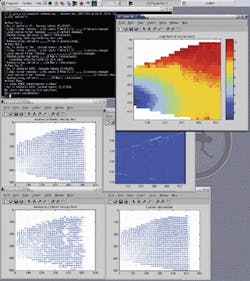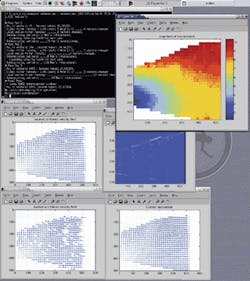Image-processing system speeds water-wave analysis
Particle image velocimetry (PIV) is an important measurement method available to fluid dynamicists. The development of PIV owes much to the simultaneous development of hardware that can perform the complex, high-speed image acquisition, processing, and storage that these measurements require. While advancements have been made during the past 20 years, consistently capturing numerous high-resolution images at high speed and storing them directly on the hard drive of a computer still remains a challenge.
At the University of Oslo Hydrodynamics Laboratory (Oslo, Norway; www.math.uio.no), researchers Atle Jensen and Kristian Sveen are measuring the water velocities during run-ups of surface waves on a beach. Working with IO Industries (London, Ont., Canada; www.ioindustries.com), they have developed a high-speed image-processing system for PIV using off-the-shelf cameras, frame grabbers, software, and a host PC.
A 10-W argon-ion laser illuminates the study area. Image acquisition is initiated through a signal from the wave maker. A CA-D6-0512 digital camera from Dalsa (Waterloo, Ont., Canada; www.dalsa.com) with 542 × 530-pixel resolution and 8-bit color captures up to 262 frames/s and is synchronized with a scanner for timing control. Images are transferred via a PC-DIG-L frame grabber from Coreco Imaging (St. Laurent, QC, Canada; www.imaging.com) in a dual-Pentium III computer with a 64-bit motherboard. The PC-DIG frame grabber connects to the Dalsa camera through a 32-bit differential interface. To store the large quantity of data transferred, the motherboard contains an on-board Ultra160 SCSI controller from Adaptec (Milpitas, CA; www.adaptec.com) that saves images on four fast SCSI RAID disks.
At the University of Oslo Hydrodynamics Laboratory, research-ers measure the velocities during run-up of surface waves on a beach. To do so, they have developed image-processing software that visually shows the velocity field (bottom left), interpolated outliers (bottom right), and the magnitude of displacement (top right).
"Initially, a hardware RAID controller was used to free some processor power, but benchmark tests revealed that it did not provide the required writing speed," says Jensen. Tests using the onboard SCSI controller have shown that the system is capable of delivering data of 90- to 130-Mbyte/s throughput to the hard drive. This performance implies that the system is capable of storing continuous data flow from the camera operating at approximately 75 Mbytes/s.
"This system provides the speed and reliability that is crucial to the success of our experiments. In addition, the RAID can store large quantities of data, enabling us to perform a long series of experiments," adds Jensen. After images are captured using Video Savant software from IO Industries, a software toolbox called MatPIV running in MatLab from The MathWorks (Natick, MA; www.mathworks.com) interrogates the images in an iterative way. The software, which is freely available (www.math.uio.no/~jks/matpiv/), provides image capture, analysis, and display of the images' vector field and its detailed properties.
"In MatPIV software," says Jensen, "interrogation windows can be made smaller and can be shifted using the first estimate, and subsequent re-estimate, to calculate the displacement value. Any number of iterations can be applied to any size of image. In these experiments, a mask is typically applied to each image pair manually, and, where as many as 262 frames/s are captured, this can be an extensive task. Further software developments will lead to a simple dynamic masking facility," he adds.
Results from the experiments with run-up of solitary surface waves will be compared with computations. The results will eventually translate into practical applications in offshore drilling, biology, and meteorology," Jensen says.

